Gallery
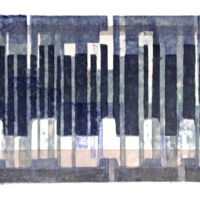
Untitled (Blue Geometric Blocks), undated, woodcut, 17 x 23.25 in.
This geometric composition was created of layers of blues and greys, with passages of the white ground of the paper punctuating these tranquil colors. The abstract image, comprised of vertical rectangular shapes and horizontal stripes, allows for multiple interpretations of the representation. Does the print depict a cityscape, an industrial mechanism, or some other linear or gridded element of modern life? Like Untitled (People), the shapes and color handling of this work are reminiscent of mid-century Abstract Expressionist and color field paintings.
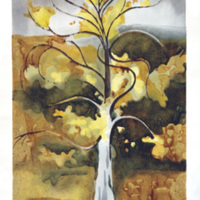
Catalpa Tree, 1982, woodcut and screen print, 1982, 24 x 17 in.
The Catalpa Tree is a very elegant tree that has yellow and brown hued leaves and is indigenous to Alabama. The depicted curves give the tree life and movement as if it is about to perform a dance for us. This energetic image exemplifies Barnes’ interest in local nature, as well as her penchant for using multiple printing processes to layer imagery upon itself, resulting in one-of-a-kind prints.
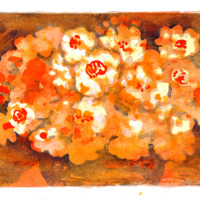
Untitled (Orange Flowers), 1983, woodcut and watercolor, 16 x 22.75 in.
Virginia Barnes frequently depicted flowers, but her flower compositions are all singular. She returned to certain species and types of floral arrangements from time to time, but varied the color palette, as well as the combination of printing processes used to create each image. In this case, Barnes applied watercolor on top of the woodcut print. The thickly applied paint adds texture to the image. This is another example of Barnes’ experiments in printmaking. Hand-coloring the work perhaps stunts the reproductive potential of the image, made with the woodcut process.
#challenge: Who were other experimental printmakers in the history of art? Post your thoughts to social media using #VirginiaBarnes #connected
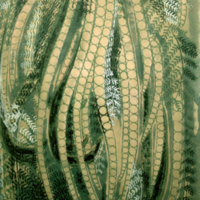
Untitled (Abstracted Grass), undated, woodcut and aqua-graph, 24.25 x 18.25 in.
This print represents several layers of green growth, one of which bears resemblance to Southern Maidenhair Fern, commonly found in Shelby County. (The fronds look like they could have been printed from a living specimen.) Alternatively, these forms might represent seaweeds or sea grasses. The energetic vertical lines convey upward motion or growth, as if the fronds and blades are reaching towards sunlight. This is one of several prints included in this exhibition reflecting Barnes’ interest in plant life and the natural beauty around Montevallo.
#challenge: What is your favorite kind of flower or plant found around campus? Post your thoughts to social media using #VirginiaBarnes #connected
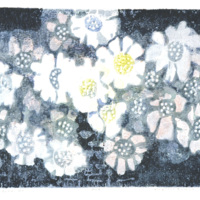
Flowers in a Basket, 1981, woodcut, 15.25 x 22.5 in.
This print depicts a deeply layered bouquet of an unidentifiable flower. The white ground of the paper is used to represent many of the flowers’ petals. The three blossoms in the middle have yellow centers; the rest of the flowers are comprised of varying shades of blue and grey along with the white of the paper. The deep blue background is irregular, with splotches and speckles, perhaps happy accidents of the printing process, populating the lower left quadrant.
#challenge: How is a woodcut print made? Watch this short video demonstration of the process, and then post your reactions to social media using #VirginiaBarnes #connected
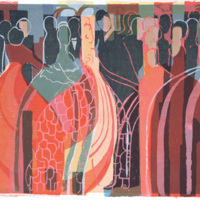
Untitled (People), c. 1950, screen print, 18 x 24 in.
Using energetic lines and bold colors, Barnes depicts figures outfitted for merrymaking in this print. Some forms appear to wear ball gowns that consist of patterns and curving lines that carry the viewer’s gaze from one dress to another. At least one figure, in the center of the composition, appears to wear a bow tie and tuxedo. The composition encourages movement, our eyes dancing across the sheet along with the represented people. The gestural quality and color palette of this print are reminiscent of the Abstract Expressionist paintings of Barnes’ teacher, Hans Hofmann (1880-1966).
#challenge: Can you imagine why these figures are dressed in ball gowns and formal attire? Post your thoughts to social media using #VirginiaBarnes #connected
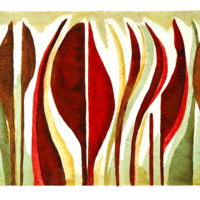
Leaf Shapes, 1975, woodcut, 16 x 23.75 in.
This arresting wood-block print depicts an orderly row of abstracted plant shapes painted in deep shades of crimson, yellow ochre, mossy green, and chestnut brown. The leaves are not recognizable as belonging to any particular type of Southern fauna, but are undoubtedly meant to depict the changing colors of autumn foliage. At the same time, it appears that multiple views of a leaf have been captured, with slivers of brown, green, and red evoking the view of a leaf’s edge, and broader swathes of colors suggesting other angles, profiles, and frontal views of the forms.
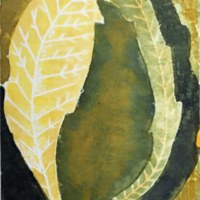
Untitled (Leaves), c. 1970-1984, woodcut and watercolor, 15.75 X 23.75 in.
This piece depicts multiple leaves that vary in color as well as in texture. Some are composed of lighter greens and yellows with veins throughout, others with darker colors. The stacked leaves all bend towards the center, forming together a rounded shape that occupies the majority of the sheet of paper. It is unclear exactly what type(s) of leaves are featured because of their abstraction, but this print might depict leaves that represent different seasons.
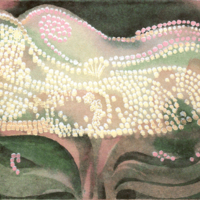
Elderberry in Bud, 1984, woodcut, screen print, and aqua-graph, 16.25 x 23.5 in.
This representation of an elderberry flower is comprised of abstracted organic shapes that suggest loosely clustered, pliable forms. The lacy white blooms have been reduced to small circular shapes, repeated across the flower form. The application of colors also conveys a sense of energy or movement. Created with a combination of printing processes that results in a rich and layered image, this print is representative of Barnes’ innovative printmaking and affinity for subjects drawn from nature. She pioneered the aqua-graph process and coined the term herself.
#challenge: Which season or phase of the elderberry life cycle do you think this image represents? Post your thoughts to social media using #VirginiaBarnes #connected